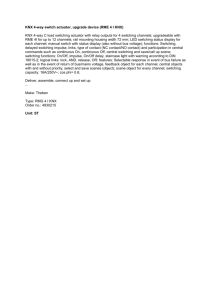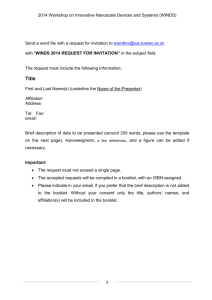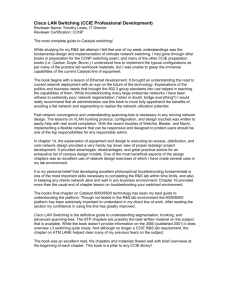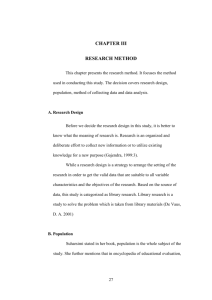CHAPTER 2 - Library & Knowledge Center
advertisement
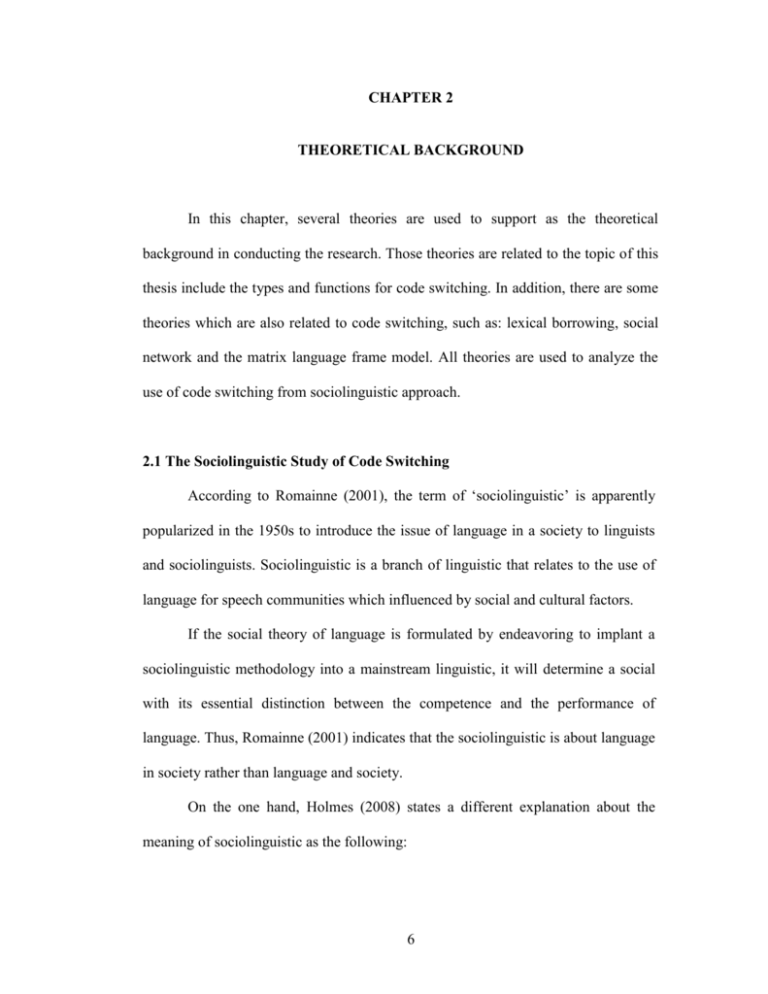
CHAPTER 2 THEORETICAL BACKGROUND In this chapter, several theories are used to support as the theoretical background in conducting the research. Those theories are related to the topic of this thesis include the types and functions for code switching. In addition, there are some theories which are also related to code switching, such as: lexical borrowing, social network and the matrix language frame model. All theories are used to analyze the use of code switching from sociolinguistic approach. 2.1 The Sociolinguistic Study of Code Switching According to Romainne (2001), the term of ‘sociolinguistic’ is apparently popularized in the 1950s to introduce the issue of language in a society to linguists and sociolinguists. Sociolinguistic is a branch of linguistic that relates to the use of language for speech communities which influenced by social and cultural factors. If the social theory of language is formulated by endeavoring to implant a sociolinguistic methodology into a mainstream linguistic, it will determine a social with its essential distinction between the competence and the performance of language. Thus, Romainne (2001) indicates that the sociolinguistic is about language in society rather than language and society. On the one hand, Holmes (2008) states a different explanation about the meaning of sociolinguistic as the following: 6 7 Sociolinguistics study the relationship between language and society. They are interested in explaining why we speak differently in different social contexts, and they are concerned with identifying the social functions of language and the ways it is used to convey social meaning. (Holmes, 2001, p.1) Wardhaugh (2010) defines that “a society is any group of people who are drawn together for a certain purpose or purposes.” He also defines that “a language is what the members of a particular society speak.” According to Wardhaugh (2010), a society may be categorized as a bilingual because most of people may use more than one language in their conversation. In addition, Trudgill (2000) reveals that language is not basically used to communicate the information. It means that language is a very significant object for establishing the relationships with the other people. It can be concluded that that there are two important aspects of language behaviour from a social point of view: establishing social relationships and conveying information. Both aspects reveal the fact that there is a close inter-relationship between language and society. (Trudgill, 2000, p.2) Nowadays, most of people tend to use more than one language in a society. The use of multi language is considered as a bilingual and engaged in code switching. The phenomenon of code switching has become the most used by many people in social network society. Code switching is the practice of using more than one language in a conversation and it generally occurs in a society. Therefore, code switching can be categorized as a part of sociolinguistic study. 8 2.1.1 Code Switching The historical background of code switching is popularly happened in the 1970s. As a consequence, Code switching has been used by people throughout the world, especially in bilingual condition. As stated in chapter 1, Bullock & Terebio (2009) defines that “code switching is the ability on the part of bilinguals to alternate effortlessly between their two languages.” Besides, there are many researchers who identify the meaning and the implication of code switching particularly. As stated in Shin (2010), Gumperz (1982) defines code-switching as “the juxtaposition within the same speech exchange of passages of speech belonging to two different grammatical systems or subsystems.” Basically, code switching can be used as the alternation of language. Auer (1999) asserts that the transformation of the popularity of code switching has developed from something ordinary to an ordinary linguistic issue which is analyzed grammatically and transformed to the group identities and ethnic boundary through verbal language. Brown & Nelson (2009) adds that “code switching is the ability to use your knowledge of two or more cultures or languages and switches between them, depending on situation, in order to best communicate your message.” On the other hand, the use of term code-switching can be described into two ways. They are language-switching and code-switching. Coulmas (2005) revealed that: Yet, the social meanings that are linked with the member of these pairs (Swahili and English) and the mechanism underlying individual choices are sufficiently akin to create the need to cover concurrent choices from both kinds of pairs with a single term. This is one of the reasons for using the term “code-switching’, rather than ‘language-switching’. (Coulmas, 2005, p. 110) 9 It can be assumed that “a code in this sense can be a language or a variety of a language” based on the book in Codes and Consequences Choosing Linguistic Varieties by MyerScotton (1998), as cited in Coulmas (2005). On the other hand, McCormick (2002) stipulates: “I refer to language varieties and to switch between them as “codes” and “code switching” only where the varieties and the switching between them seems to have some significance for the members of the speech community.” It means that McCormick refers to it as a language switching where it acts as a variety language. As a result, there are many arguments about the definition and the term of code switching. Almost all of the sociolinguistics, especially for the code switching theorists, states that code switching is the alternation of using two or more languages in a conversation with many varieties of language in a society. 2.1.2 Lexical Borrowing Lexical borrowing is a part of switching which borrow words from another language. It also happens when there is a lack of vocabulary in a language. (Holmes, 2008) This kind of switching can be also stated as code mixing. According to Holmes (2008), “borrowed words are usually adapted to the speaker’s first language.” The pronounciation of borrowed words is used grammatically as if they were part of the speaker’s first language. For many countries, specifically in Indonesian, there are many borrowing word. For example, the word of “international” is borrowed as “internasional” in Indonesian. The word of “internasional” is adapted by Indonesian. Some theorists of sociolinguistic distinguish the relation between borrowing and code switching. Poplack (2000), as stated in Li Wei (2008), claims that borrowing language 10 can show signs of convergence, while code switching maintains the identity and relationship. Besides, Gardner-Chloros (2008) distinguishes code switching from loans in the borrowing language. First, borrowing language can provide lexical gaps, while code switching may appear for many reasons. Second, borrowing words tend to be used phonologically and morphologically and assimilated with the surrounded language, whereas code switching retains the first language. It can be concluded that borrowing and code switching can be distinguished based on occurrence of linguistic integration. 2.1.3 Code Switching and Social Network Theory Social Network is almost used by all people around the world. The way of using social network is the easiest to be understood. Prell (2011) explains: “A social network can be defined as set of relations that apply to a set of actors, as well as any additional information on those actors and relations.” He states that social network connect between the users and the relations in the social society. Additionally, social network theory is suggested as an appropriate means which relates to code switching and language choices by individual to broader social, economic and political contexts (Li Wei, Milroy, Pong 2000). They finds that some young member of the Chinese community on Tyneside have a fluently conversation with the oldest member of monolingual Chinese speakers. Gardner-Chloros (2008) concludes that “Their social networking with people their own age is also governed by their linguistic abilities and their associations with English or Chinese speakers in turn reinforce their preferences and abilities in those languages.” Conversely, Yusuf (2012) finds that code switching usually happens in a younger generation’s conversation. The use of code switching is rarely found by a young person to parents or elders. 11 2.1.4 Common Terms on Twitter According to Elliot (2009), “social networking and micro-blogging sensation Twitter has spawned its own language, from the basic to the obscure.” There are many common terms and explanations about the way of using Twitter that are different from other social networks. Twitter is a microblogging service because it only allows updating messages of 140 characters to say or share what is happening. All of the messages are called as a “tweet”. Twitter users are referred to as Tweeters, Twitterers, or Tweeps. On Twitter, the networks are determined by the term of “following” and “followers”. Following means an activity to follow someone on Twitter to receive someone’s tweets. By following someone on Twitter can be categorized as a follower. The more the number of followers and following on Twitter a Twitterer has, the more social networks that will be obtained. In order to get a conversation with followers, Twitter provides several ways to contact directly. Direct Messages (DM) are the way to keep private tweets which only can be seen by followers who send the message. Direct Messages are needed to keep a private conversation. Meanwhile, reply and mention are the way to speak directly to someone by putting the “@” symbol in front of the name and all followers can see it. Mention is usually used to start a conversation with followers, while reply is applied to reply the message from mention. Moreover, there are common Twitter term such as Retweet and Hashtag. Twitterers use retweet to repost tweets from another user. RT is an abbreviation to signify that Twitterers have retweeted a tweet which is helpful, interesting or important information. Hashtag refers to the action to make a topic becoming popular. Twitterers 12 can use “#” in front of the topic to filter tweets by subject or category. It is an effective tool for spreading common news item or popular topic. 2.2 Types of Code Switching Code switching has been classified into many types by some researchers or sociolinguistics expert. For that reason, there are some explanations about types of code switching from several researchers whom engage in code switching. According to Gumperz (1982), there are two main types of code switching practices: situational code switching and metaphorical code switching. Situational code switching refers to the change of a language which is caused of the change of situation, participant, setting and activity type. Conversely, metaphorical code switching refers to be used as a conversational strategy in particular topic rather than social situation. By contrast, there are only two types of code switching that is stated by MyerScotton (1997, as cited in Coulmas, 2005). Those types are intersentential switching “which is lesser interest for structure-focused code switching research” and intrasentential switching “which treats the complement phrase with mixed constituents as the relevant unit for analysis.” On the other hand, Poplack (1981) as cited in Jalil (2009) categorizes three types of code switching. The first type is tag switching. This switching is usually used only at fillers or tags, such as: I mean, you know, at least. It is a very simple switching and the risk of violation of grammatical rules is seldom to be happened. For instance, from a Portuguese-English bilingual: 13 Example 1 “I look like Lilica, you know, nunca paro!” [I look like Lilica, you know, I never stop!] (Jalil, 2009) The second type of code switching is the intersentential switching. It is a switching at phrase, clause or sentence level which happens between sentence boundaries. One of the titles of Poplack’s papers can be an example of intersentential switching. This title is named in English and Spanish: Example 2 “Sometimes I’ll start a sentence in Spanish y termino en español” [Sometimes I’ll start a sentence in Spanish and finish in Spanish]. (Poplack in Jalil, 2009) The last type is intrasentential code switching. It is the most complex types of code switching because the risk violation of syntactic rules is higher than those previous types. An example of intrasentential is taken from Romainne (1995) in English and Chinese language: Example 3 What’s so funny? Come, be good. Otherwise, yu bai go long cot. (What’s so funny? Come, be good. Otherwise, you will go to court) (Romainne, 1995) The other researchers, Li Wei (1998) suggests three levels of code switching. They are Level A, Level B and Level C. Level A can be considered as “intersentential switching”. It is applied when a speaker switches a language into different language and being responded by a different language in a conversation. For example, there is a conversation between English and Chinese from Tyneside community, which collected by Li Wei (1998): 14 Level A: Example 4: Mother: You Child: Ngaw I (I want some, John? m yiu not want don’t want) The next level is Level B. It is definitely affected when one speaker use two or more than two languages in one speech. This level is identified as “intrasentential switching”. One of the examples below is switched from Japanese to English by Azuma (1993): Level B: Example 5: Uchi wa whole chicken o kau noyo we TOPIC whole chicken ACC. buy TAG (We buy a whole chicken) Code switching is categorized into the last level, Level C. This level is if a single word, phrase, idiom or expression is expressed in one sentence with different language. This level is labeled as “Lexical Borrowing” because this level is hardly explained in primary language. An example of this level is also from Li Wei (1998) below. Level C: Example 6: So it means kudei gong do di yingmen lo they speak more English PA (So it means they speak more English) In general, there are many types of code switching which has been established by some researchers. Nevertheless, the writer only focuses on the types of Intrasentential switching and Intersentential switching by Poplack (1981 in Jalil 2009). The participants in this research use written language in code switching studies on Twitter. Both intrasentential and intersentential are suitable to be analyzed in this study. 15 2.3 The Matrix Language Frame Model According to Myer-Scotton & Jake (2001), the different aspect of code switching data which belongs to the framework of the Matrix Language Frame model will imply how grammatical structure is explained linguistically. She also states that “The Matrix Language is a theoretical construct universally applicable to all code switching data sets, regardless of the specific language pairs involved.” The Matrix Language Frame is originally a model of intrasentential code switching. It has been proved that intrasentential switching data usually belongs to the single word or phrase. MyerScotton & Jake (2001) list three types of code switching constituents with the opposition in the Matrix Language Frame model (The Matrix Language (ML) vs. Embedded Language (EL) and the content vs. system morpheme distinction). Those three types are explained in the following and given each example based on Matrix language in Indonesian version: 1. mixed or ML + EL constituents, with morphemes from two or more languages. For example: Example 7 Semua nilai ujian kalian akan segera di-post-ing di Binus maya. (All marks of your test will be posted on Binus maya) 2. ML islands, constituents with morphemes solely from ML and well-formed according to ML grammar. An example will be given below: Example 8 Bagian yang paling menarik dari buku ini adalah bagian introduction dan conclusion-nya. 16 (The most interesting part from this book is its introduction and conclusion) Ada beberapa assignment yang harus saya selesaikan. (There are some assignments that I have to finish) 3. EL islands, constituents with morphemes solely from the EL and well formed according to the EL grammar. For instance: Example 9 Dear temans, jangan lupa datang ke pesta ulang tahunku. ok! (Dear friends, don’t forget to come to my party. ok!) Besides, there are The Morpheme Order Principle and The System Morpheme Principle that are applied by Myers-Scotton (1993): The Morpheme Order Principle: In ML + EL constituents consisting of singly occurring EL lexemes and any number of ML morphemes, surface morpheme order will be that of the ML. The System Morpheme Principle: In ML + EL constituents, all system morphemes which have grammatical relations external to their head constituent will come from ML. The Morpheme Order Principle states that the matrix language will dictate the morpheme order in ML + EL constituents. For example, there are two EL morphemes which are not EL islands, but rather parts of ML + EL constituents. It means that they follow ML Morpheme Order. On the other hand, The System Morpheme Principle reveals that the system morphemes will come from the ML only, except they are contained within an EL island. 17 2.4 Functions of Code Switching Holmes (2008) states that people are not always aware that they use code switching. They may perform code switching unconsciously when they communicate to each other. Nonetheless, there are some functions of using code switching in their daily communication. For explaining the various functions of code switching, Holmes (2008) classifies some functions with the example below. 1. Showing solidarity The switch usually happens when there is a change in the social situation. The change in a situation is clearly described in many ways, such as the sudden appearance of a person or the present of a new participant in a social situation. The use of code switching may be related to a particular participant or addressee. This kind of switching is depicted in the following example by Holmes (2008): Example 10: (The Maori is in italics. THE TRANSLATION IS IN SMALL CAPITALS) Sarah: I think everyone’s here except Mere. John: She said she might be a bit late but actually I think that’s her arriving now Sarah: You’re right. Kia ora Mere. Haere mai. Kei te pehea koe? (HI MERE. COME IN. HOW ARE YOU?) Mere: Kia ora e hoa! Kei te pai. Have you started yet? (HELLO MY FRIEND. I’M FINE) In this example, there is a code switching between Maori and English. The conversation is spoken in English. Then, Sarah switches her language to Maori because Mere is come from Maori. The Maori greeting from Sarah is an expression of solidarity to Mere. 18 2. Signaling ethnic identity The ethnic identity is one of the factors of using code switching. A speaker may also switch to another language for signaling the speaker’s ethnic identity and solidarity with the addressee. Even the switching is done by only using brief phrases and words because the speakers are not very expert in a second language. Holmes (2008) mentions that Maori people often use Maori words and phrases for social reasons to signal ethnic identity. Here is an example. Example 11 (a) Tamati: Engari (so) now we turn to more important matters (Switch between Maori and English) (b) Ming: Confiscated by Customs, da gai (PROBABLY) (c) A: Well I’m glad I met you. OK? M: andale pues (OK SWELL), and do come again. Mm? (Switch between Spanish and English) There are three different conversations above. In (a), Tamati uses a Maori tag at the beginning of his utterance. The rest utterance is spoken in English. By contrast, Ming uses a Mandarin tag as a final tag in (b). Those switching is occasionally called emblematic switching or tag switching. It is purely an interjection in the other language which serves as an ethnic identity marker. The other example in (c) occurs between two Mexican Americans or Chicanos in United States. They use the Spanish tag to signify the relevance of their shared ethnic background to their future relationship. The tag shows a solidarity marker between two minority ethnic group members. 3. Changing topic A switch from one language to another language can happen in the change of a topic. The topic can change from informal to formal interaction or from the status relations between people. The example of this function is explained below. 19 Example 12 (BOKMAL IS IN SMALL CAPITALS. Ranamal in lower case.) Jan: Hello Petter. How is your wife now? Petter: Oh she’s much better thank you Jan. DO YOU THINK YOU COULD HELP WITH THIS PESKY FORM? I AM HAVING A GREAT DEAL OF DIFFICULTY WITH IT. Petter: OF COURSE. GIVE IT, HERE … The example above points out that people may switch code to discuss a particular topic in a speech event. They talk about personal interaction as a neighbor into a more formal interaction as bureaucrat and member of the public. This kind of role switch happens regularly in multilingual communities. 4. Quoting someone or something People may also use code switching to signal a quotation. The switch acts like a set of quotation marks which only concern on the words that the speakers want to quote. By using quotation mark, the speaker can give an accurate or inaccurate impression about the correct words that the speaker used. The example of this function is illustrated below. Example 13 (The Maori is in italics. THE TRANSLATION IS IN SMALL CAPITALS) A Maori person is recalling the visit of a respected elder to a nearby town. “That’s what he said in Blenheim. Ki a matou Ngati Porou, te Maoritanga I papi ake I te whenua. (WE OF THE NGATI POROU TRIBE BELIEVE THE ORIGINS OF MAORITANGA ARE IN THE EARTH) And those Blenheim people listened carefully to him too.” Based on above example, a speaker from Maori switches code to quote a person. The speaker switches English to Maori to quote what a person has ever said in Bleinheim. Besides quoting a person, code switch is also used to quote a proverb or a well-known saying in another language, as depicted below. 20 Example 14 (The Mandarin Chinese is in italics. THE TRANSLATION IS IN SMALL CAPITALS) Li: People here get divorced too easily. Like exchanging faulty goods. In china it’s not the same. Jia gou sui gou, jia ji sui ji. (IF YOU HAVE MARRIED A DOG, YOU FOLLOW A DOG, IF YOU’VE MARRIED A CHICKEN, YOU FOLLOW A CHICKEN.) This kind of switch is functioned to quote a proverb from Chinese. The meaning of proverb can be different if it is said in another language. Therefore, the speaker prefers to use Chinese to quote the real proverb. 5. Affective functions Most bilingual and multilingual communities are adept in exploiting rhetorical effects of their linguistic repertoire. In Paraguay, Guarani (L variety), is more appropriate for joking and humorous anecdotes while discussing political issues in Spanish. Moreover, the switching can be used to express the feeling of the speaker. There are many kinds of feelings, such as: happy, sad, disappointed, excited, angry and so on. The following example is used to express disapproval. Example 15 (The German is in italics. THE TRANSLATION IS IN SMALL CAPITALS) In the town of Oberwart two little Hungarian-speaking children were playing in the woodshed and knocked over a carefully stacked pile of firewood. Their grandfather walked in and said in Hungarian, the language he usually used to them: ‘Szo! Ide dzuni! Jeszt jeramunyi mind e kettuotok, no hat akkor!” (WELL COME HERE! PUT ALL THIS WAY, BOTH OF YOU, WELL NOW.) When they did not respond quickly enough he switched to (dialectal) German: “Kum her!” (COME HERE!) The switching example is exactly expressed first in Hungarian and then in German. There is a distinction between Hungarian and German. In Oberwart, German is the language of the school and officialdom, while Hungarian is usually used at home. Hungarian symbolizes solidarity and friendship. On the one hand, German represents 21 authority. By using German, the grandfather expresses his anger and disapproval of the children’s behaviour. In addition to function derived from Holmes (2008), there are some discourse functions of code switching by Gumperz (1982), as cited in Wiradisastra (2006). Some of them are to distinguish between direct and indirect speech, to serve as interjection, repetition and message qualification. The example of first discourse function is given below from Wiradisastra (2006): Example 16 Gue nanya dong tell me the difference and then maybe we can try and do something kan... benerin kan. (naturally I asked tell me the difference and then maybe we can try and do something to improve it) In example 16, there is a switch from Indonesian to English. It is used to mark indirect speech. The second function is to serve as interjection or sentence fillers as in the following example: Example 17 I mean... bukan cuma scenerynya aja tapi ya experience lo (I mean not only the scenery but also your experience) (Wiradisastra, 2006) The third discourse function is to clarify a message or as a repetition. The example is given below: Example 18 I miss you so much. Zhen de hen xiang ni. (really miss you) (I miss you so much. Really miss you) The example of fourth discourse function about message qualification is illustrated below: Example 19 Tia’s another version of Citra, tapi yang lebih moderen. Lebih girly. Atau lebih tomboy. Yang masih down to earth. 22 [Tia’s another version of Citra, but more modern. More girly. Or more of a tomboy. She is still down to earth]. Based on above example, there is a conversation which talks about different model. The characteristic of Tia are explained in English to qualify a message. Besides, there is an additional function that is expressed by the Sert (2005) in The Internet TSL Journal. Sert (2005) classifies the functions of students’ code switching. One of the functions is equivalence. In this function, the students switch a term by using the native of equivalent of a certain lexical item in target language without altering the meaning. An example has been made by Munoz & Mora (2006): Example 20 T: Do you remember what weight is? When you go and (?) my weight, the teacher’s weight is 75 kilograms. S: Peso, el Peso! (WEIGHT, WEIGHT!) T: aaahh? Excuse me? C: Peso! (WEIGHT!) In this example, Munoz & Mora (2006) state that the students switch their languages to Spanish in order to apply the equivalence function. This function is intended to clarify the meaning of weight. Moreover, the equivalence function is not only used when they talk to the teacher, but also to their classmates. There are still many other functions of code switching which have been identified by another researcher in code switching. Based on the data observation, almost all of the functions that are used by the participants are adapted from Gumperz’s discourse function, Sert (2005) and Holmes (2008). The further research about the analysis of the type and function of code switching will be conducted in the next chapter.




